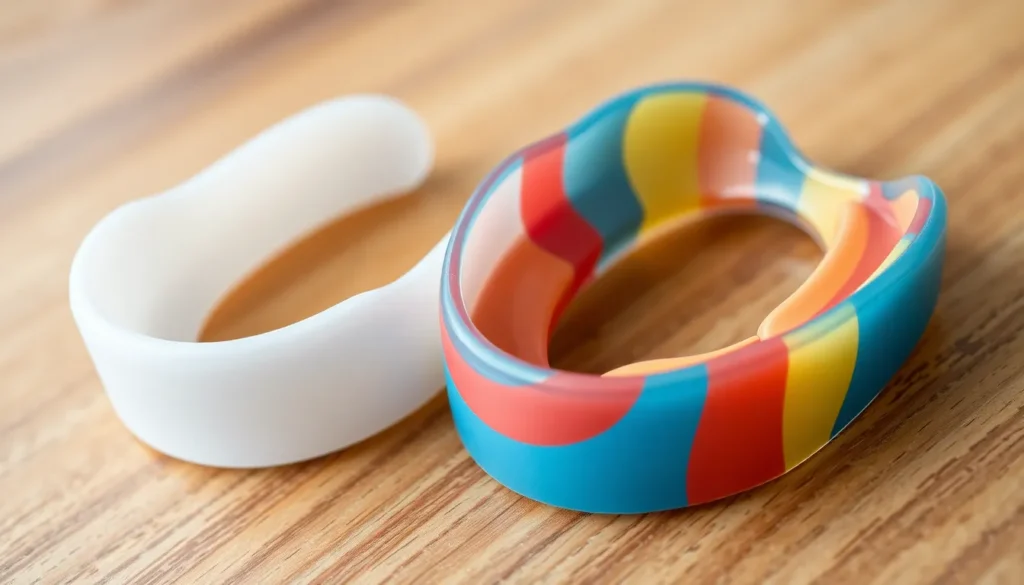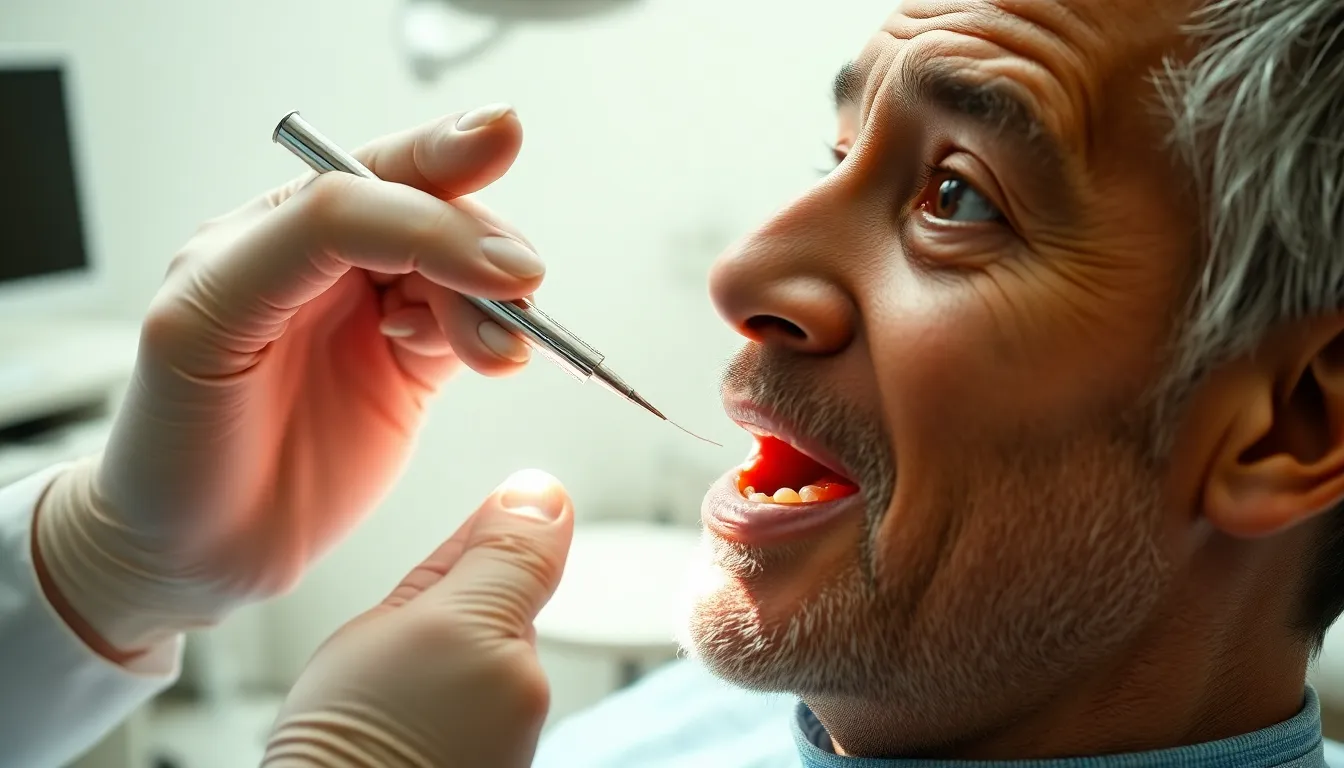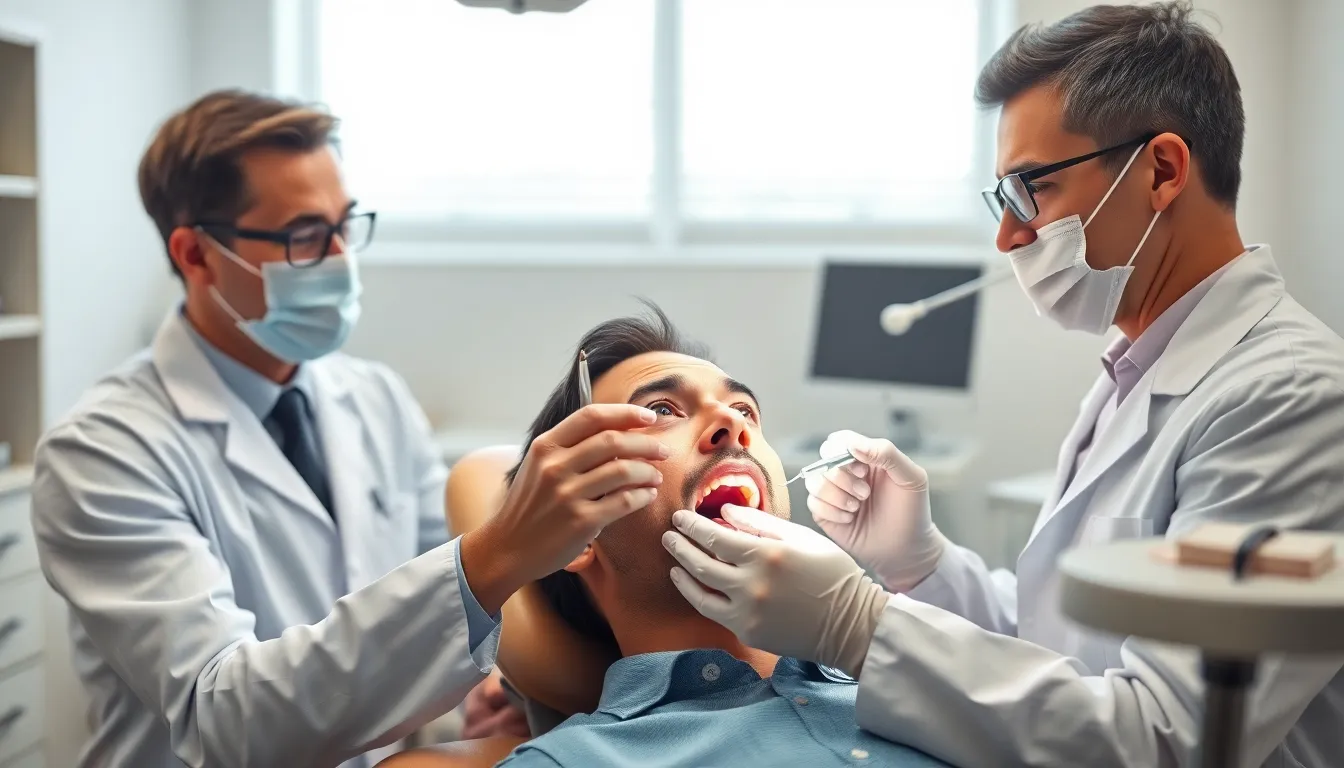Ever wondered about the difference between a mouth splint and a mouth guard? While these dental devices may look similar at first peek, they serve distinctly different purposes for your oral health.
Mouth splints are typically prescribed by dentists to treat conditions like TMJ disorders and bruxism (teeth grinding), offering therapeutic benefits during sleep. Mouth guards, on the other hand, are primarily protective devices designed to shield your teeth from impact during sports or physical activities. Understanding which device you need could make all the difference in addressing your exact dental concerns effectively.
What Are Mouth Splints and Mouth Guards?
Mouth splints and mouth guards are dental appliances designed for different oral health purposes. These devices serve unique functions even though their similar appearance, with one focusing on therapeutic benefits and the other on protection.
Mouth Splints Explained
Mouth splints are custom-fitted dental devices created specifically to address temporomandibular joint (TMJ) disorders and bruxism (teeth grinding). Your dentist designs these therapeutic appliances to reposition your jaw, relieve muscle tension, and protect teeth from grinding damage during sleep. Most splints are made from hard acrylic that covers either the upper or lower teeth, creating a barrier between dental arches.
Dr. Todd B. Harris notes, “Many of my patients experience important relief from chronic jaw pain within just 2-3 weeks of consistent splint use. One patient, Sarah, had suffered from debilitating morning headaches for years before we identified her nighttime grinding habit and fitted her with a custom splint.”
Mouth Guards Explained
Mouth guards are protective devices primarily used during sports and physical activities to prevent dental injuries. These guards absorb and distribute impact forces that might otherwise damage your teeth, lips, cheeks, and tongue. Athletic mouth guards typically cover the upper teeth and come in three varieties: stock (pre-formed), boil-and-bite (semi-custom), and custom-made. Custom guards offer superior protection and comfort compared to over-the-counter alternatives.
Sports organizations recommend mouth guards for activities with collision risks, including football, basketball, hockey, and martial arts. Athletes wearing properly fitted mouth guards experience 60% fewer dental injuries than unprotected participants. The American Dental Association reports that mouth guards prevent approximately 200,000 oral injuries annually in high school and collegiate sports.
Key Differences Between Mouth Splints and Mouth Guards
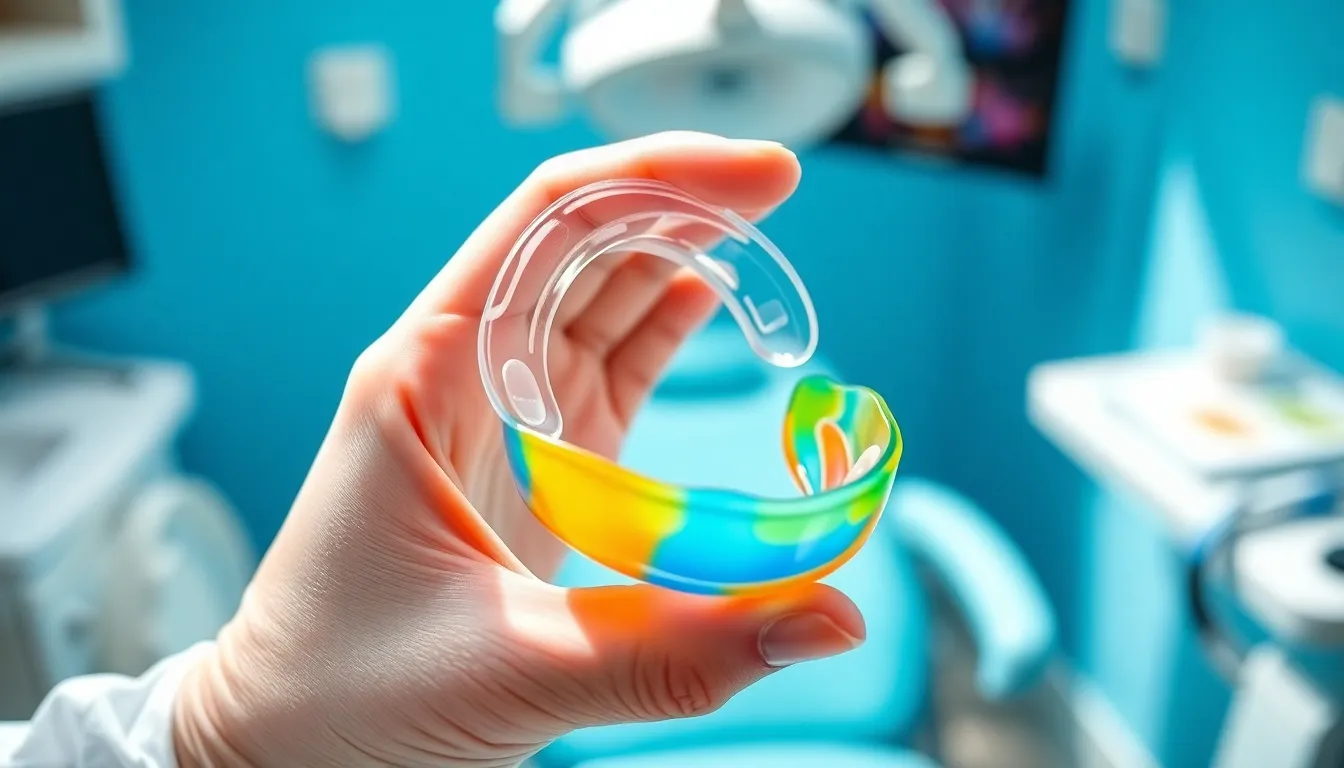
Mouth splints and mouth guards serve distinct purposes even though their similar appearance. Understanding their differences helps you choose the right oral appliance for your exact needs.
Design and Construction
Mouth guards feature softer, flexible plastic designed specifically to absorb shocks during physical activities. They provide a cushioning layer that protects your teeth, lips, gums, and other oral tissues from impact injuries. The flexibility allows for comfortable wear during active movements and speaking.
Mouth splints (also called dental splints, bite splints, or occlusal splints) are constructed from harder, more durable plastic materials. These custom-fitted devices hold your teeth in a stable position with firmness that prevents movement. The rigid construction creates a barrier between upper and lower teeth, effectively preventing contact during grinding or clenching episodes.
Dr. Todd B. Harris notes, “I’ve seen countless patients confused about which device they need. A patient once came in with a sports mouth guard thinking it would help her TMJ pain, but she needed the structural support only a proper splint could provide. After getting fitted for a custom splint, her jaw pain decreased significantly within weeks.”
Primary Purpose and Function
Mouth guards primarily protect against traumatic dental injuries during sports or high-impact activities. They cushion blows to the face, minimizing damage to teeth, lips, tongue, and gums. Athletic associations recommend them for contact sports like football, hockey, and basketball to reduce the risk of broken teeth and soft tissue injuries.
Mouth splints serve therapeutic purposes by addressing existing dental conditions. They prevent tooth damage from bruxism (teeth grinding) and clenching, particularly during sleep. TMJ splints, a specialized type, provide vertical support and guide your jaw into an optimal resting position, relieving muscle tension and stabilizing the temporomandibular joint. Many patients wear splints nightly for long-term management of these conditions, while some TMJ patients benefit from daytime wear as well.
The functional differences extend to treatment protocols—mouth guards typically come out after the game ends, while splints become part of your nightly routine, working silently to protect your dental health while you sleep.
When to Use a Mouth Splint

Mouth splints are therapeutic devices prescribed by dental professionals for exact conditions affecting jaw function and teeth health. These custom-made appliances provide both protection and therapeutic benefits for patients experiencing particular oral health issues.
TMJ Disorders and Bruxism
Temporomandibular joint (TMJ) disorders require specialized treatment approaches, and mouth splints serve as an effective non-surgical intervention. These splints stabilize your jaw by repositioning it into a more natural position, significantly reducing strain on the joint and surrounding muscles. The vertical support provided by splints helps alleviate common TMJ symptoms including jaw pain, clicking sounds, and limited jaw movement.
Bruxism, characterized by unconscious teeth grinding and clenching, causes considerable dental damage over time. Mouth splints create a protective barrier between your upper and lower teeth, preventing the harmful effects of grinding forces. Unlike standard night guards, splints offer additional jaw positioning benefits that address the underlying causes of bruxism.
Dr. Todd B. Harris often tells his patients, “Many people come to me thinking they just need something to stop their teeth from wearing down, but what they truly need is a properly designed splint that corrects their jaw alignment while protecting their dental structures.”
Comfort and Fit Considerations
Custom-fitted mouth splints provide superior comfort compared to over-the-counter alternatives due to their precise adaptation to your dental anatomy. These devices are fabricated from harder, more durable plastics specifically designed to withstand the intense forces generated during clenching or grinding episodes.
Proper fit ensures maximum therapeutic benefit, as splints must remain securely in place throughout the night to maintain jaw alignment. Your dental professional takes detailed impressions of your teeth to create a splint that fits tightly over either your upper or lower dental arch, depending on your exact condition and treatment goals.
Many patients initially report an adjustment period with their splints. One TMJ patient shared, “The first few nights with my splint felt strange, but within a week, I noticed dramatic improvement in my morning headaches and jaw tension that I’d been suffering with for years.”
Daily wear patterns vary based on individual needs – some patients benefit from wearing their splints only during sleep, while others with severe TMJ disorders might require daytime use as well to maintain proper jaw positioning throughout the day.
When to Use a Mouth Guard

Mouth guards serve as protective barriers for your teeth during physical activities. Unlike therapeutic mouth splints used for TMJ disorders, mouth guards are specifically designed to prevent dental injuries from impact.
Sports and Athletic Protection
Athletic mouth guards are essential equipment for anyone participating in contact sports like football, basketball, hockey, boxing, and wrestling. These protective devices shield your teeth, lips, tongue, jaw, and facial structure from potential trauma during play. Athletes wearing properly fitted mouth guards experience 60% fewer dental injuries compared to those who don’t use this protection.
Basketball player Michael Thompson shares, “I never thought I needed a mouth guard until I took an elbow to the face during a game. My custom-fitted guard saved me from losing two front teeth. Now I never step on the court without it.”
The American Dental Association recommends mouth guards for both competitive and recreational athletes in any activity where collisions or falls might occur. Your risk of dental injury increases dramatically without proper protection during sports activities where contact with other players, equipment, or playing surfaces is possible.
Types of Mouth Guards Available
Custom-fitted mouth guards offer superior protection and comfort as they’re precisely molded to your dental structure by dental professionals. These guards provide the most secure fit and maximum protection, though they represent the most expensive option.
Boil-and-bite mouth guards present a more affordable alternative that you can purchase at sporting goods stores. These thermoplastic guards soften in boiling water, allowing you to create a semi-custom fit by biting down while the material cools and hardens.
Stock mouth guards come pre-formed and ready to wear immediately after purchase. While these offer the lowest cost option, they provide minimal customization and often feel bulky or uncomfortable. Their protective capabilities are generally inferior to other types.
Cost Comparison and Insurance Coverage

Custom mouth splints cost significantly more than mouth guards, with prices typically ranging from $500 to $600. Fixed dental splints attached permanently to teeth can cost between $100 and $400 per tooth depending on your dentist and the exact type of splint needed. The higher price reflects the therapeutic purpose and customized nature of these devices.
Mouth guards vary in price based on their type and quality:
- Custom-fitted night guards provide superior protection but come at a premium compared to store-bought options
- Boil-and-bite guards offer moderate pricing with some customization potential
- Stock mouth guards represent the most affordable option but deliver the least comfortable fit
“Many patients experience sticker shock when they learn about the cost difference between therapeutic splints and protective guards,” notes Dr. Todd B. Harris. “I remind them that splints are precision medical devices designed to treat exact conditions, not just protective equipment.”
Insurance coverage differs substantially between these dental appliances. Most dental insurance plans cover mouth splints only when they’re medically necessary for treating diagnosed conditions like bruxism or TMJ disorders. Custom dental splints prescribed by dentists often receive partial coverage, though you’ll likely need to pay a portion out-of-pocket through co-pays or deductibles.
Over-the-counter mouth guards rarely qualify for insurance coverage since they’re considered preventive items rather than prescription devices. Fixed dental splints might be covered under certain restorative procedures, depending on your exact dental insurance policy.
| Device | Typical Cost | Insurance Coverage | Primary Purpose |
|---|---|---|---|
| Custom Mouth Splint | $500-$600 | Partially covered when medically necessary | Treat bruxism, TMJ disorders |
| Fixed Dental Splint | $100-$400 per tooth | Coverage varies by policy | Permanent tooth stabilization |
| Custom Night Guard | Moderate to high | Partial coverage if medically required | Protect against grinding |
| Boil-and-Bite Guard | Low to moderate | Rarely covered | Sports protection, basic grinding |
| Stock Mouth Guard | Lowest | Not covered | Basic sports protection |
Professional Consultation: When to See a Dentist
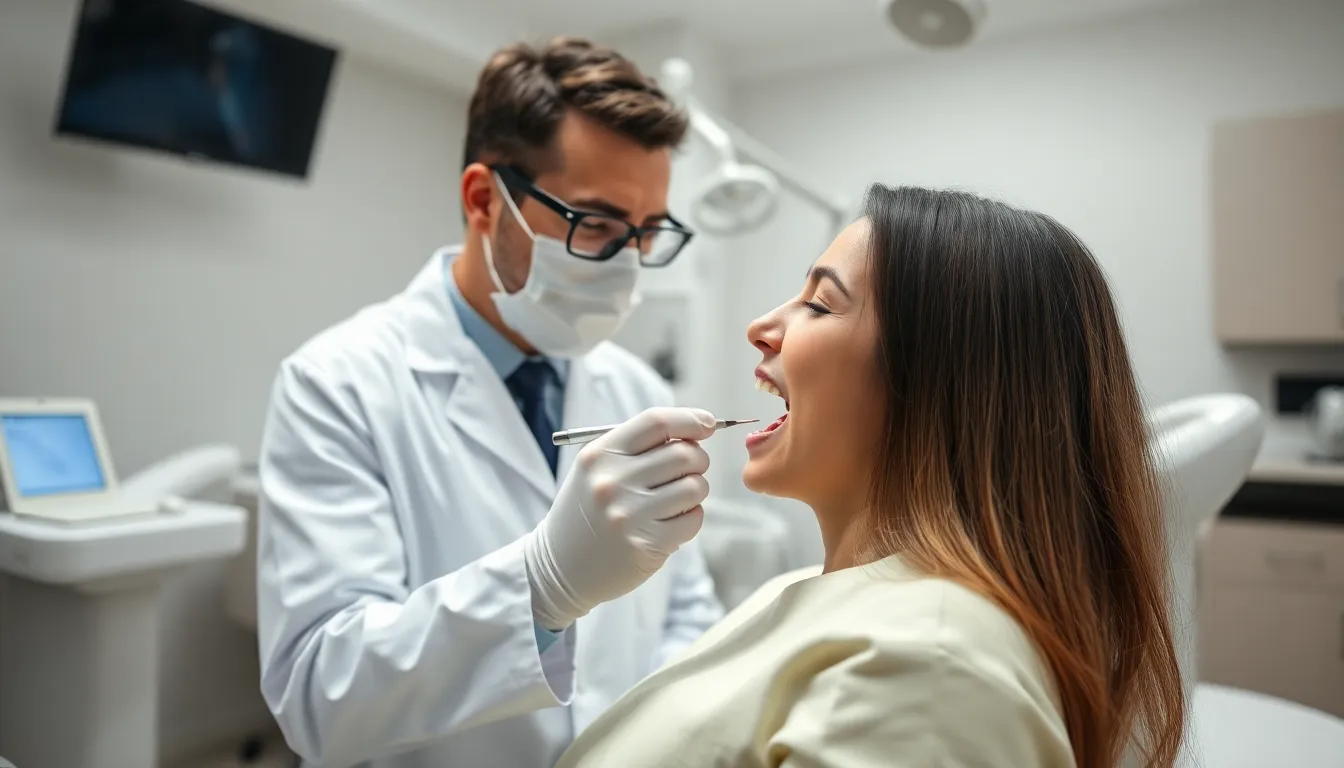
Consulting with a dental professional is essential when determining whether you need a mouth splint or mouth guard. Dentists provide expert evaluation of your exact oral health needs and recommend the appropriate device based on your symptoms and lifestyle factors.
Signs You Need Professional Advice
Several indicators suggest it’s time to schedule a dental appointment:
- Persistent jaw pain or soreness when waking up in the morning
- Frequent headaches that seem to originate from the temple area
- Worn down or flattened teeth visible during dental examinations
- Clicking or popping sounds in your jaw joint during movement
- Teeth sensitivity that wasn’t present before
- Participation in contact sports or high-impact physical activities
Dr. Todd B. Harris notes, “Many patients come to my office confused about whether they need a splint or guard. One patient arrived complaining of severe morning headaches and jaw pain, convinced she needed a sports mouth guard. After examination, I discovered classic signs of nighttime bruxism and TMJ disorder, which required a therapeutic mouth splint instead.”
Diagnostic Process
The diagnostic process dentists use includes:
- Comprehensive oral examination to assess tooth wear patterns and jaw alignment
- Discussion of symptoms and their frequency, duration, and intensity
- Evaluation of jaw movement to identify restrictions or abnormalities
- Review of medical history for contributing factors like stress or medication side effects
- Possible X-rays or imaging to examine jaw joint structures
Custom Fitting Process
Custom-fitted devices provide superior benefits compared to over-the-counter alternatives. Dentists create these personalized appliances through:
- Taking dental impressions of your teeth using specialized materials
- Creating accurate models of your dental anatomy
- Designing the device specifically for your condition and mouth structure
- Testing and adjusting the fit during follow-up appointments
One basketball player shared, “After breaking a tooth during practice, my dentist fitted me with a custom mouth guard. The difference in comfort and protection compared to my old store-bought guard was remarkable—I can breathe, speak, and play without even noticing it’s there.”
Follow-up Care
Regular dental check-ups remain crucial after receiving your mouth splint or guard. Your dentist will:
- Monitor your device’s effectiveness in addressing symptoms
- Assess any wear and tear on the appliance
- Make necessary adjustments to improve comfort and function
- Evaluate your overall oral health for any new developments
Dentists typically recommend scheduling follow-up appointments every 6 months, though patients with progressive TMJ disorders might need more frequent monitoring to ensure optimal therapeutic benefits from their mouth splint.
Maintenance and Care Tips
Proper maintenance extends the life of your oral devices and ensures they remain hygienic and effective. Daily care routines significantly reduce bacteria buildup and prevent odors that commonly develop on regularly used mouth appliances.
Cleaning and Storage
Clean your mouth guard or splint daily after each use to remove bacteria and debris that accumulate during wear. Use mild soap or non-abrasive toothpaste with a soft-bristled toothbrush to gently scrub all surfaces without causing damage. Avoid hot water when cleaning as it can warp or distort the material, compromising the fit and effectiveness of your device. Rinse thoroughly before and after each use to remove any saliva, food particles, or cleaning agents.
Store your oral device in a ventilated case that allows air circulation, preventing moisture buildup that leads to bacterial growth. Regular cleaning of the storage case itself is essential—many patients forget this step, allowing contaminants to recolonize a freshly cleaned device. Keep your mouth guard or splint away from direct sunlight and heat sources that could deform its carefully designed shape.
“I had a patient who stored her expensive custom mouth splint wrapped in tissue on her nightstand,” recalls Dr. Todd B. Harris. “Within weeks, it developed an unpleasant odor and warped slightly after being accidentally left near a window. Proper storage would have prevented a premature $500 replacement.”
Replacement Timeline
Replace mouth guards and night guards every 6–12 months, depending on visible wear patterns and material integrity. Signs indicating immediate replacement include cracks, tears, holes, or deformation that affect the fit and protective capabilities. Your bite pattern changes subtly over time, so even devices that appear intact may no longer provide optimal protection or therapeutic benefits.
Mouth splints typically last longer than athletic mouth guards due to their harder materials, but require regular professional evaluation to assess their condition and effectiveness. Patients with severe bruxism may need more frequent replacements as grinding forces can wear down even the most durable materials.
Regular dental checkups should include an assessment of your oral device. Many dental practices offer maintenance programs that include professional cleaning and evaluation of your mouth guard or splint during routine visits. These professional cleanings remove calcified deposits that home cleaning methods can’t effectively address.
Conclusion
Choosing between a mouth splint and mouth guard comes down to your exact needs. While mouth splints serve as therapeutic devices for TMJ disorders and bruxism during sleep, mouth guards protect your teeth during physical activities and sports.
Custom-fitted options provide the best results for both devices though at different price points. Your dental insurance may cover splints when medically necessary but rarely covers protective mouth guards.
Remember to consult with your dentist if you experience jaw pain, headaches or teeth sensitivity. They’ll help determine which oral appliance is right for you and ensure proper fitting.
With proper care and regular replacement, your chosen device will effectively protect your smile and support your overall oral health for years to come.
Frequently Asked Questions
What is the difference between a mouth splint and a mouth guard?
Mouth splints are therapeutic devices prescribed by dentists to treat conditions like TMJ disorders and bruxism, worn primarily during sleep. They’re made from hard materials to reposition the jaw and prevent tooth movement. Mouth guards are protective devices made from softer, flexible plastic designed to shield teeth from impact during sports and physical activities.
When should I use a mouth splint?
You should use a mouth splint if you have specific oral health issues like TMJ disorders or bruxism (teeth grinding). These therapeutic devices are typically worn at night to stabilize your jaw, alleviate symptoms like jaw pain, and protect your teeth from grinding damage. A dentist will determine if you need one after evaluating your symptoms.
When should I use a mouth guard?
Use a mouth guard during physical activities, especially contact sports like football, basketball, and boxing. The American Dental Association recommends mouth guards for all athletes to prevent dental injuries. They act as protective barriers that absorb and distribute impact forces, significantly reducing the risk of tooth damage.
How much do mouth splints cost?
Custom mouth splints typically cost between $500 and $600. Fixed dental splints can range from $100 to $400 per tooth. These prices reflect the personalized nature of the devices and the professional expertise required for proper fitting. Insurance may cover them if deemed medically necessary for conditions like TMJ disorders or severe bruxism.
How much do mouth guards cost?
Mouth guard costs vary by type: stock mouth guards are the least expensive ($1-$15), boil-and-bite guards range from $15-$30, while custom-fitted guards from dentists cost $200-$500. Custom night guards for grinding may cost $300-$600. Sports-specific guards typically fall between $15-$35 for store-bought options and $200-$500 for professional ones.
Does insurance cover mouth splints and guards?
Insurance typically covers mouth splints only when medically necessary for diagnosed conditions like TMJ disorders or severe bruxism. Coverage usually requires proper documentation from your dentist. Over-the-counter mouth guards rarely qualify for insurance coverage, though custom mouth guards might be partially covered under certain dental plans. Always check with your insurance provider.
How long do mouth splints and guards last?
Mouth guards typically need replacement every 6-12 months, depending on wear and tear. Mouth splints generally last longer (2-5 years) due to their harder materials, but should be professionally evaluated annually. Children and teens may need more frequent replacements as their mouths develop. Replace immediately if you notice cracks, tears, or deformation.
How do I clean my mouth splint or guard?
Clean your device daily using mild soap or non-abrasive toothpaste and a soft toothbrush. Rinse thoroughly with cool water (hot water can warp the material). Avoid mouthwash containing alcohol as it can damage some materials. After cleaning, allow it to air dry completely before storing in a ventilated case to prevent bacterial growth.
How do I know if I need a mouth splint?
You may need a mouth splint if you experience persistent jaw pain, frequent headaches (especially in the morning), worn or sensitive teeth, clicking or popping jaw sounds, limited jaw movement, or if your partner reports hearing you grind your teeth at night. Consult a dentist for proper diagnosis and treatment recommendations.
Can I use a sports mouth guard for teeth grinding?
No, you shouldn’t use a sports mouth guard for teeth grinding. Sports guards are made from softer materials designed to absorb impact, not to withstand the consistent pressure of grinding. A proper night guard or mouth splint is specifically designed with harder materials to prevent damage from grinding and to properly position your jaw.

